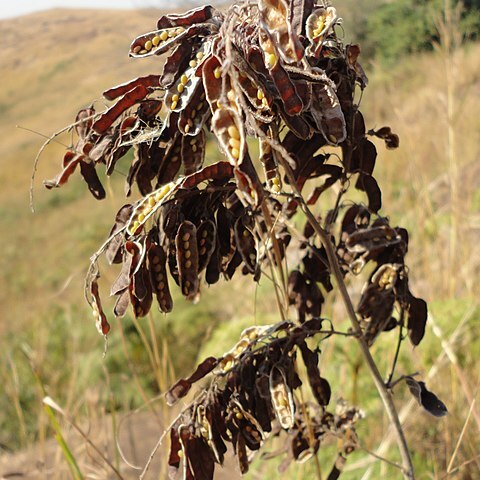Erect woody herb or subshrub 0.3-3(4) m tall, from a thick rhizome. Stems strongly ribbed, pubescent to velvety. Leaflets 2.5-16.5 x 1.3-10 cm, elliptic or obovate-elliptic, acute to rounded and mucronulate at the apex, cuneate or rounded at the base, subentire or more usually broadly crenulate, somewhat rough on the upper surface, pubescent to velvety beneath; petiole 1-7 cm long, channelled; rhachis 2-30 mm long; petiolules 2-10 mm long; stipules 5-12 x (1)2-5 mm, eventually falling. Inflorescences usually much branched and very lax with numerous flowers; peduncle 0-10 cm long; rhachis 6-35 cm long; pedicels 3-8 mm long, at first erect, later reflexed; primary bracts 3-10 x 1-2 mm, ovate-lanceolate, acuminate, persistent; secondary bracts 2-3 mm long, linear. Corolla reddish-purple, blue, rose or white; standard 6-8 x 4-6.5 mm, rounded. Fruit straight, 12-38 x 3-4(5) mm, 3-12-seeded, puberulous or subtomentellous. Seeds chestnut-brown, compressed, smooth, c. 2 x 1.2 x 0.8 mm, reniform or oblong-ovoid.
Perennial, erect to suberect, herb or subshrub, up to 3 m high; arising from thick rhizomatous, woody rootstock; stems strongly ribbed, tomentose-villous with white or yellow hairs. Leaves pinnately trifoliolate. Leaflets elliptic or obovate-elliptic, pubescent to velvety below. Stipules lanceolate-attenuate. Inflorescences often much-branched and very lax racemes, sometimes paniculate, bracteate. Flowers pink. Flowering time Nov.-May. Pod linear-oblong or slightly falcate, compressed, with sutures straight or slightly sinuate, imperfectly articulated.
Leaflets 2.5–16.5 × 1.3–10 cm, elliptic or obovate-elliptic, acute to rounded and mucronulate at the apex, cuneate or rounded at the base, subentire or more usually broadly crenulate, somewhat rough on the upper surface, pubescent to velvety beneath; petiole 1–7 cm long, channelled; rhachis 2–30 mm long; petiolules 2–10 mm long; stipules 5–12 × (1)2–5 mm, eventually falling.
Inflorescences usually much branched and very lax with numerous flowers; peduncle 0–10 cm long; rhachis 6–35 cm long; pedicels 3–8 mm long, at first erect, later reflexed; primary bracts 3–10 × 1–2 mm, ovate-lanceolate, acuminate, persistent; secondary bracts 2–3 mm long, linear.
Seeds chestnut-brown, compressed, smooth, c. 2 × 1.2 × 0.8 mm, reniform or oblong-ovoid.
Fruit straight, 12–38 × 3–4(5) mm, 3–12-seeded, puberulous or subtomentellous.
Corolla reddish-purple, blue, rose or white; standard 6–8 × 4–6.5 mm, rounded.
Erect woody herb or subshrub 0.3–3(4) m tall, from a thick rhizome.
Flowers small in copious panicles, white, yellow or pink
An erect, stiffly branched shrub, 6–10 ft. high
Stems strongly ribbed, pubescent to velvety.
Easily confused with Desmodium salicifolium.
Grey-downy all over

